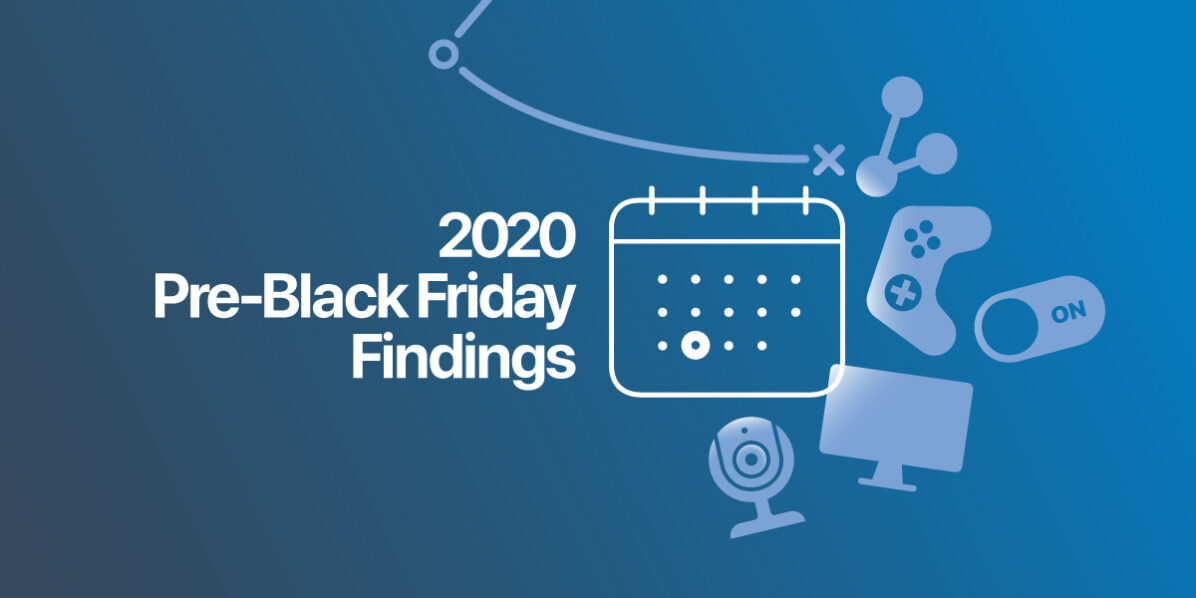Amidst changing consumer preferences, new COVID-related safety measures, and supply-chain setbacks, many marketers are adapting their playbooks in preparation for an unprecedented holiday season. With the majority of consumers working from home due to the COVID-19 pandemic, this year’s Black Friday and Cyber Monday (BFCM) events are bound to be unprecedented.
Big retailers are also closing brick and mortar locations to address public health concerns and to decrease overhead costs. As a result, the current climate is quite unpredictable and at times unsteady. How can brands cut through the noise ahead of the Holiday season to win big?
It’s important for advertisers and brands alike to take a close look at the recent consumer trends in order to properly pivot in order to have a successful Black Friday, Cyber Monday, and Holiday Season. Read on for key pre-Black Friday insights and findings.
Black Friday and Cyber Monday Starts Early
Due to the unprecedented and sometimes chaotic nature of the global pandemic, it’s no surprise that consumers may feel overwhelmed or indecisive. A recent consumer report by Fluent revealed that 59% of consumers are unsure when or how they will conduct their holiday shopping.

This presents advertisers with a keen opportunity to help consumers make a holiday shopping plan. By making sure online offers and shopping experiences closely mimic in-person shopping experiences, advertisers can tap into consumers’ needs for a sense of normalcy and familiarity.
Further, many brands are launching their holiday and BFCM deals earlier this year. Walmart started promoting their annual Black Friday sale on the 4th of November. Some brands are even planning on continuing to have BFCM offers beyond the thanksgiving weekend as an incentive to get indecisive shoppers to engage.
This may be an advantageous tactic, especially because as we draw near to the holidays, shipping times are expected to increase because online orders have doubled during the pandemic — pre-Holiday season no less. As a brand, it’s important to be very vocal about shipping times. Having constant reminders on websites, in ads and on social media will help to ensure that consumers know when they need to place an order by to receive their delivery in time for the holidays. Recently, there’s also been a shift towards offering free expedited shipping, as opposed to just free standard shipping.
Was Amazon Prime Day Too Early?
Another big change this year was Amazon Prime Day. Amazon typically holds their annual 2-day savings event during the summer. This year however, they opted to have it in October.
According to Fluent’s consumer Pulse report, 22% of surveyed consumer didn’t shop this prime day. Prime day was likely too close to Black Friday to make it worth it for consumers who didn’t participate this year. These consumers are likely waiting for better deals, like the ones typically seen during BFCM. What does this mean for your brand? COVID-19 has led to individuals being placed on leave or furloughed. At this time, shoppers may be putting a greater emphasis on the value of offers and sales. As a result, there has been a recent shift towards deep discounting with some marketers promoting 70% off first-time purchases.

Another reason for the reduced Prime day participation could be that certain consumers could have been waiting to make up their mind. As we saw from Fluent’s findings, users may not know how to go about shopping this holiday season. This is an opportunity for advertisers to reduce friction and to remove barriers to entry. Making their holiday shopping as painless as possible is sure to be a strong motivator.
Lastly, those who did participate in this year’s Prime day savings event spent more than in previous years. This suggests that consumers who do have the means may be spending more online than ever before. There’s also been an uptick in ‘self-gifting’, likely as a result of restrictions and health guidelines and the impact they’ve had on people’s ‘self-care’ routines.
Mimic In-Person Shopping Where Possible
The pandemic has brought on quite a few unique shopping experiences. More than ever, there is an emphasis on Click and Collect, Buy Online Pick-Up in Store (BOPIS) and curbside pickup orders to ease tensions around shopping in stores. There is also a big emphasis on highlighting any changes that have been made to ensure in-store safety protocols.

Where pickup or in-store shopping experiences aren’t possible, it’s important to make sure that online shopping experiences feel familiar and comfortable to shoppers.
This includes:
- Adding deep links to your emails, ads or app notifications and push notifications will make it easier for shoppers to find items they’re interested in.
- Adding a pop-up before users check out can entice users to grab a few more items like they would in a check-out aisle in stores.
- Offering ‘at-home kits’ for experiences users can no longer have in person (for example, a pre-cooked Thanksgiving meal or an at-home gel manicure set) can increase the bottom line by tapping into new audiences while filling a gap in the market caused by restrictions and closure.
If you’re pivoting, pivot with intention. This is a great time to do it!
Christmas Compassion – Give the Gift of Giving
Since a large number of people are concerned about savings, it’d be greatly advantageous for advertisers to lean into that; people are looking for help this year given that loads of folks have been affected by COVID-19. Any deal or offer that will lower a barrier to entry for shoppers will yield better results.

There has also been a shift recently where brands are leaning in to more philanthropic and ‘here to help’ messaging and offers to ease concerns around holiday spending and expensive items. Others are actually giving back (via their offers) to COVID relief initiatives, unemployment, or homelessness relief programs. There’s also a big focus on helping small and local businesses who may be struggling due to the pandemic.
Ensuring that messaging and collateral leverages these points where possible (and in a genuine way) is a great way to help consumers get through their gift lists while simultaneously giving back to the community.
Hit the Ground Running this Holiday Season
Given these insights, advertisers should aim to offer more aggressive deals, start Black Friday deals earlier and potentially after Thanksgiving to catch late buyers, and add ‘up-selling’ campaigns to their media plans to capture multi/big purchase consumers.
For more holiday shopping tips and tricks, make sure to watch Fluent’s latest webinar, Holiday Shopping Insights: Trends & Insights for Marketers.
If you are interested in taking your performance to the next level, let’s chat. We’re here to help!
